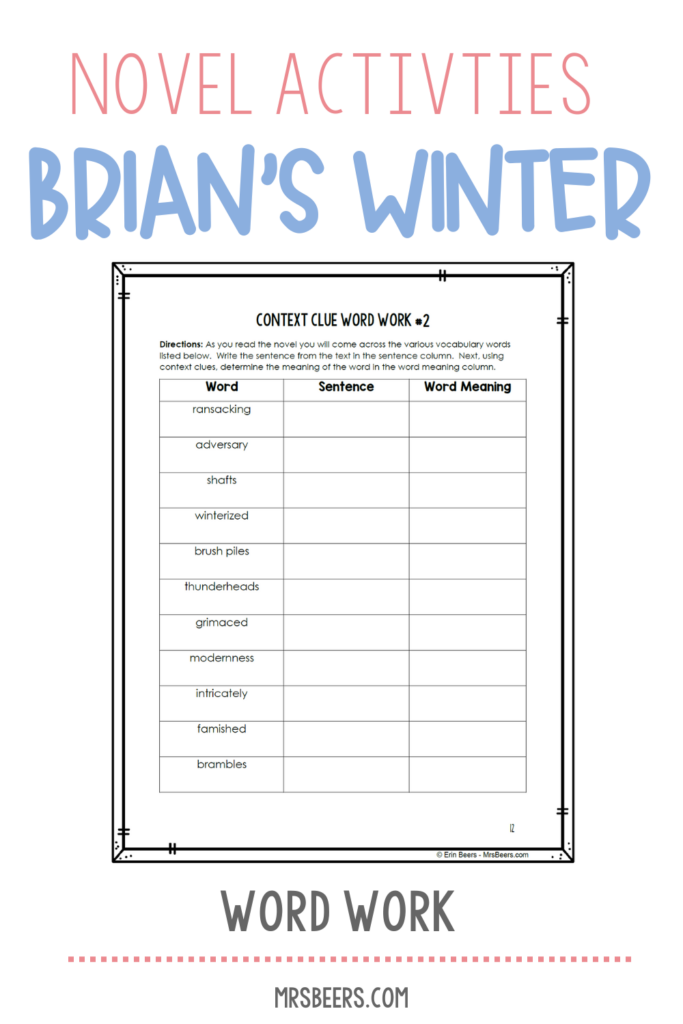
One of my favorite winter-themed books for middle school is Brian’s Winter by Gary Paulsen. It makes for a great novel study during the winter months, as your students will be AMAZED at Brian’s ingenuity to survive the brutal winter. The book is a continuation of the novel Hatchet, but written as if Brian Robeson had never been rescued from the Canadian woods.
If you have never read this book, definitely add it to your classroom library because your students will LOVE it! You won’t hear much complaining about the cold temperatures once they read everything this 13-year-old Brian does to survive winter in the Canadian woods after a plane crash.
Novel Study Ideas and Activities
I use a similar lesson plan structure for all of the novels we read together in class. As you can see in the notes below, I lead off each day with a discussion around the assigned reading selection. For my favorite chapters, I highlight a couple pages to read aloud before beginning our discussion.

A couple of easy “icebreakers” to begin each day include reviewing the setting of our reading selection, which in this case relates to the cold and snowy conditions in Canada during winter. Students will be able to connect their winter with the one Brian Robeson is experiencing. Class discussions like this help students hear how their peers interpret and connect to the story.
All of the lesson plans and novel study activities featured here are included in my Brian’s Winter Novel Study Unit. This PDF download features over 45 pages of daily lesson plans, reading comprehension questions, context clue worksheets, and journal prompts.
I’ve used this novel unit in my own classroom for several years. As a fan of the book myself, I wanted to create a resource that would help my students focus on the setting, characters, and feelings within the story.
Vocabulary and Word Work

Instead of handing out a list of vocabulary words from the novel to memorize, I like to utilize context clue worksheets that require them to go back into the text and decipher what a word means. The ability to use context clues is an important skill that they need to practice for state testing. My Brian’s Winter novel unit includes 5 context clue worksheets with about 50 different words
Figurative Language
Author Gary Paulsen uses an incredible array of figurative language in this book. I created this “simile or metaphor” worksheet to challenge student’s awareness of the difference between these two concepts. This is something they will be tested on in the spring, so it is good to review it together while I have these examples from the book.
Guided Peer Discussion

These Brian’s Winter Chit Chat Cards give my students the chance to discuss the novel without having to write or record any of their thoughts. They simply read the chapter-based card and discuss their ideas with a partner, in a small group, or as a whole class. These simple guided discussion prompts enhance the discourse component, which is essential to enhancing student comprehension.
Whether chatting about the text during reading class, small group time, or in literacy centers, students are always enthusiastic about sharing their thoughts with classmates about this high-interest novel. It is a great way to generate positive engagement for your novel study.
More Ideas for Brian’s Winter
In addition to the novel study activities I highlighted above, my Brian’s Winter Novel Study features all of the essential reading comprehension components as well as some other great activities. Here is the full list…
- Chapter by Chapter Lesson Plans
- Chapter by Chapter Reader Response Questions
- Pre-Reading Novel Summary
- Character Analysis Worksheet
- Story Map Activity
- Author Interview: End of Novel Activity
- Teacher Answer Key
Hopefully you found a few ideas here that will help you read this book with your class. Check out the following links for more examples of novel study activities I use with my middle school students…





